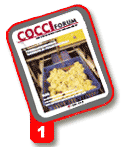Cover Story - Tying the Score
Performance of vaccinated birds equals or exceeds birds receiving traditional in-feed coccidiostats
Recent studies with roasters and
broilers finished in as little as 42
days indicate that performance
of poultry immunized with a coccidiosis
vaccine is just as good as in birds
that continuously receive an in-feed
coccidiostat.
"We're finding that with live oocyst
vaccination, we're coming closer to the
same kind of productivity you'd find in
the field with use of in-feed anticoccidials," says Dr. Harry Danforth, parasitologist
with the USDA's Agricultural
Research Center, Beltsville, Md.
In a study conducted by Dr.
Danforth, weight gain and feed efficiency
in roasters that received a live
oocyst vaccination initially lagged
behind those fed an anticoccidial. This
was expected because birds are
exposed to oocysts, or coccidia organisms,
in the vaccine that ultimately
enable the birds to develop immunity
against coccidiosis.
Performance in vaccinated birds,
however, caught up to that of the infeed
group. By the end of the study,
there was no statistically significant difference
in weight or feed efficiency
between the two groups of birds,
which were grown 56 to 63 days, Dr.
Danforth says.
The results showed not only that
vaccination with live oocysts elicited
"significant protection" against coccidiosis,
but that it resulted in "average
bird weight gains and feed efficiency
similar to that obtained with conventional
anticoccidial medications," Dr.
Danforth concludes (Int J Parasitol
1998 Jul; 28 (7):1099-109).
Results Similar in Broilers
The results were similar in broiler studies
conducted by researcher Dr. Greg.Mathis of Southern Poultry Research,
Inc., Athens, Ga.
In Dr. Mathis' study, presented last
year at the American Association of
Avian Pathologists conference, some
birds received the live oocyst vaccine at
hatching and other, nonvaccinated
birds were fed the anticoccidial salinomycin
in starter and grower feeds. The
broilers were housed in a floor pen
facility and managed as they would be
in a commercial operation.
At day 14, average feed conversion
and live weights were similar in the
vaccine and salinomycin groups. By
Day 21, an effect on performance due
to coccidiosis vaccination occurred and
the vaccinated group trailed behind the
nonvaccinated group in weight and
feed conversion.
However, by day 28, performance
in the birds receiving the anticoccidial
had declined and there was no significant
difference in weight gain or feed
conversation between the vaccinated
and in-feed groups. Performance in
both groups remained the same for the
remainder of the study, Dr. Mathis says.
Field Data Confirm Results
Field data provided by Schering Plough
Animal Health, the company that manufactures
Coccivac®-B, a live oocyst
vaccine, confirmed the results of Dr.
Mathis' floor pen studies.
Commercial flocks raised in high
temperatures during summer received
either the vaccine or an in-feed anticoccidial.
"The weights from the two programs
were identical. In fact, in the
field trials, weight and feed conversion
among vaccinated birds were sometimes
better than those of broilers
receiving salinomycin," Dr. Mathis says.
The field studies included 5- and 6-
pound broilers and demonstrated that
vaccination can be used for smaller
broilers grown to 42 days, as well as
those grown to 49 days of age.
Previous studies have shown that
vaccinating birds against coccidiosis
causes some intestinal disruption and
resulting performance loss. However,
Dr. Mathis says his research shows that
the impact on performance is only temporary.
He originally thought that the benefits
of vaccination would not outweigh
any negative impact on performance,
but the trend today is for a longer
grow-out period and further processed
birds. In this case, the benefits of
immunity can equal or exceed any loss
in performance, "especially when you
take into consideration the cost of
anticoccidial medications."
Benefits of Vaccination
The major advantage of using a coccidiosis
vaccine is improved coccidiosis
control, Dr. Danforth says. Rotating the
vaccine with coccidiostats helps combat
resistance to the in-feed products,
which is a well-recognized problem in
the poultry industry.
"I'd recommend the vaccine to
poultry producers where drug resistance
is a problem with coccidiosis, but
it depends on where you go," he says.
"In some areas, in-feed coccidiostats
still work well. In other areas of the
U.S., immunization would be a real
plus because you aren't getting as good
a result with in-feed anticoccidials."
Spray Cabinet Technology Simplifies Coccidiosis Vaccination in Poultry
Spray cabinet technology makes it easier
to administer the live oocyst coccidiosis
vaccine and helps assure even
distribution, say poultry experts.
"With the spray cabinet, you put 100
chickens in a box and mist them with
the vaccine solution," says Dr. Phil
Hargis, an independent poultry nutritionist
based in Batesville, Ark. " It's a
lot more likely that the vast majority of
chicks will get the vaccine than if workers
spray it on feed pans or if the vaccine
is administered in water."
Dr. Larry McDougald, parasitologist at the University of Georgia, Athens,
says, "We don't have the final say yet on which is the best method of distributing
this vaccine, but the newer methods, such as the spray cabinet,
are greatly improved over older methods. With water administration, the
vaccine isn't distributed properly and exposure is uneven."
Dr. Harry Danforth adds, "The spray cabinet is more likely to be accepted
because poultry producers already have spray cabinet technology to
treat for other diseases, such as bronchitis."
Other methods can be problematic. Eye administration, for instance,
requires individual birds to be handled, which isn't as efficient, he says.
"Better methods of administration may come along, but right now, the
spray cabinet is one of the best. It's simpler, quicker and takes less people
and time to do it," Dr. Danforth says.
Dr. John McCarty, a poultry veterinarian with Schering-Plough Animal
Health, explains that sprayed chicks preen and ingest the vaccine orally,
which helps obtain more uniform administration throughout a flock.
Source: CocciForum Issue No.1, Schering-Plough Animal Health.










